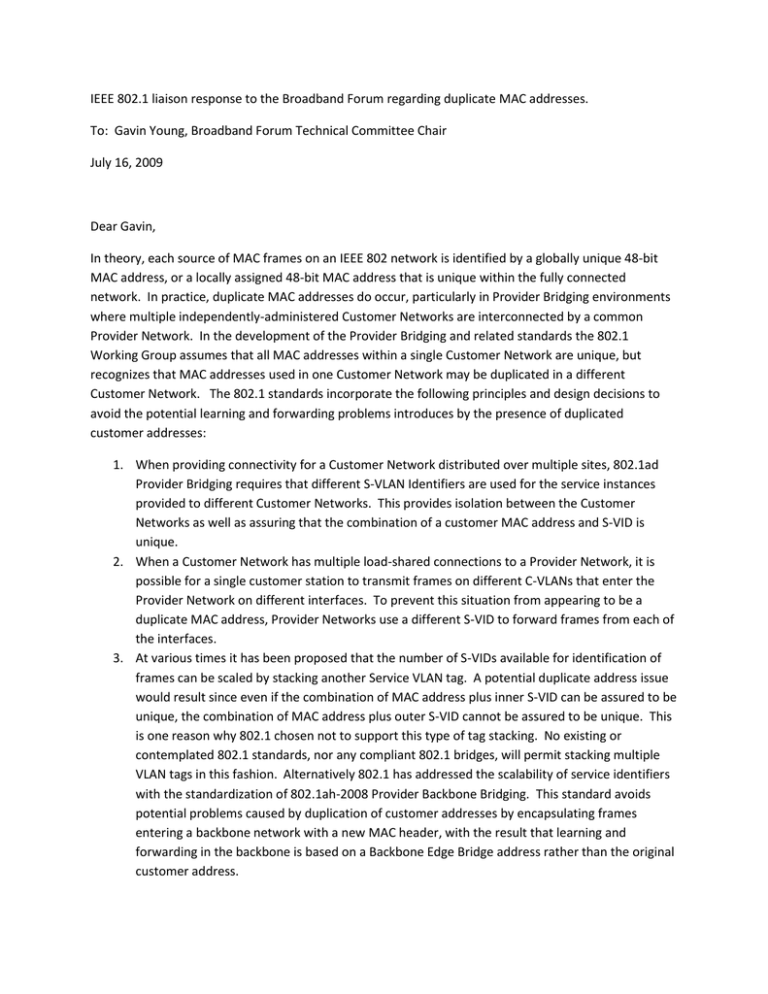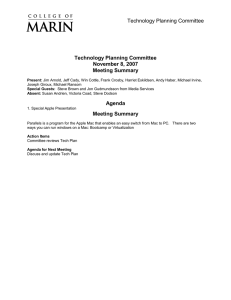IEEE 802.1 liaison response to the Broadband Forum regarding duplicate... To: Gavin Young, Broadband Forum Technical Committee Chair
advertisement

IEEE 802.1 liaison response to the Broadband Forum regarding duplicate MAC addresses. To: Gavin Young, Broadband Forum Technical Committee Chair July 16, 2009 Dear Gavin, In theory, each source of MAC frames on an IEEE 802 network is identified by a globally unique 48-bit MAC address, or a locally assigned 48-bit MAC address that is unique within the fully connected network. In practice, duplicate MAC addresses do occur, particularly in Provider Bridging environments where multiple independently-administered Customer Networks are interconnected by a common Provider Network. In the development of the Provider Bridging and related standards the 802.1 Working Group assumes that all MAC addresses within a single Customer Network are unique, but recognizes that MAC addresses used in one Customer Network may be duplicated in a different Customer Network. The 802.1 standards incorporate the following principles and design decisions to avoid the potential learning and forwarding problems introduces by the presence of duplicated customer addresses: 1. When providing connectivity for a Customer Network distributed over multiple sites, 802.1ad Provider Bridging requires that different S-VLAN Identifiers are used for the service instances provided to different Customer Networks. This provides isolation between the Customer Networks as well as assuring that the combination of a customer MAC address and S-VID is unique. 2. When a Customer Network has multiple load-shared connections to a Provider Network, it is possible for a single customer station to transmit frames on different C-VLANs that enter the Provider Network on different interfaces. To prevent this situation from appearing to be a duplicate MAC address, Provider Networks use a different S-VID to forward frames from each of the interfaces. 3. At various times it has been proposed that the number of S-VIDs available for identification of frames can be scaled by stacking another Service VLAN tag. A potential duplicate address issue would result since even if the combination of MAC address plus inner S-VID can be assured to be unique, the combination of MAC address plus outer S-VID cannot be assured to be unique. This is one reason why 802.1 chosen not to support this type of tag stacking. No existing or contemplated 802.1 standards, nor any compliant 802.1 bridges, will permit stacking multiple VLAN tags in this fashion. Alternatively 802.1 has addressed the scalability of service identifiers with the standardization of 802.1ah-2008 Provider Backbone Bridging. This standard avoids potential problems caused by duplication of customer addresses by encapsulating frames entering a backbone network with a new MAC header, with the result that learning and forwarding in the backbone is based on a Backbone Edge Bridge address rather than the original customer address. 4. In some applications multiple customers accessing a common service can be attached to the same S-VLAN or same set of asymmetric S-VLANs. In this scenario, customers with duplicate MAC addresses still need to connect to the service on distinct S-VLANs, but the number of SVIDs consumed scales with the number of copies of the same MAC address rather than the number of duplicate address pairs or the total number of customers. This is not an exhaustive list of the ways duplicate customer addresses can appear in Provider Networks, and the possible remedial actions will likely vary depending on the specific network topology or application. The 802.1 working Group would be interested in hearing more specifics on the network environment in which the BBF is encountering (or anticipates encountering) issues with duplicate addresses. There may be ways we can work together to resolve any problems that arise. Best regards,

